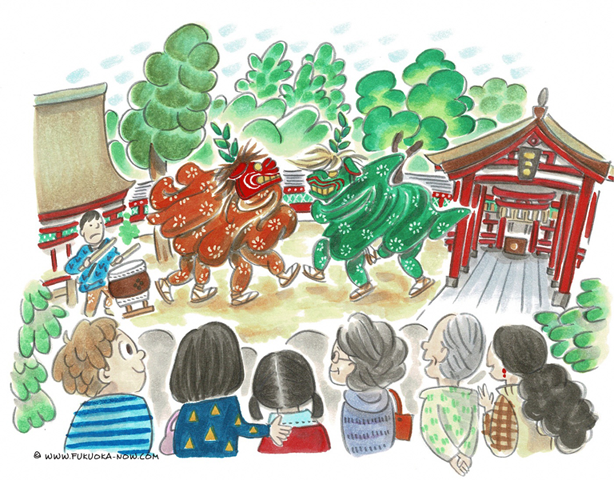Hakata Culture vol.178
Lion Dance: A Celebration of the New Year

The shishi-mai (lion dance), which is part and parcel of New Year’s celebrations, is a traditional folk dance performed by dancers wearing large lion-headed costumes. Because lions are considered spirit animals that can ward off evil, these dances are performed at many other festivals and celebrations throughout the year, not just at New Year’s. Similar traditional dances can be found throughout Asia, and the shishi-mai in Japan is thought to date back to the Nara period (710~794). The dances vary widely from region to region, but in this article, we focus on the three styles of shishi-mai that are registered as intangible cultural properties of Fukuoka City.
The first style is called gigaku. Gigaku is an ancient form of traditional masked dance from China. The most famous example of this style is the Kashii Shrine Ceremonial Lion Dance, which is performed every April and October during the shrine's grand festivals. Shrine parishioners dress up as two lions, one male and one female, and dance dynamically to the lively music of drums and flutes.
The next style of lion dances has strong theatrical and kyogen (comic theater) elements, and these include the Imajuku Aoki Shishi-mai, the Udagawara Honen Shishi-mai, and the Motooka Shishi-mai. All of these originated from lion dances that were widespread in the former counties of Itoshima and Sawara. There are several performances, including "Kadozuke," all of which depict a grand story. Over the generations, the dancers of some pieces have dwindled to zero or the dances have stopped being performed for some other reason, so some of these dances have died out.
The last style of shishi-mai is called harai-shishi (lit. "exorcism lion"). The main feature of this type of performance is that the lion does not dance, but carries a lion's head and walks around the town to purify houses, either at their entrances or in their kitchens. According to lore, if a child is “bitten” on the head by a lion, he or she will remain safe for the rest of the year and will become brighter, so you will often see people letting the lions “bite” their children’s heads. Currently, harai-shishi are performed in 24 areas throughout Fukuoka City, and together they are registered as an intangible cultural asset.
1年の始まりを祝う獅子舞
正月につきものの獅子舞は、獅子頭の被り物をして舞う民俗芸能。獅子は悪霊を退散させる霊獣とされることから、正月だけでなく祭りや祝い事の席でも獅子舞は行われます。アジア各地に同じような民俗芸能があり、日本に入ってきたのは奈良時代(700年代)と考えられています。各地に多彩なバリエーションがありますが、今回は福岡市無形文化財に登録されている獅子舞を紹介します。
福岡市内で行われている獅子舞には大きく3つの系統があります。ひとつは伎楽(ぎがく)系の獅子舞です。伎楽とは、面をつけて舞う中国から伝わった古い形の伝統演劇です。その代表といえるのが香椎宮奉納獅子楽で、毎年4月と10月の香椎宮の大祭で奉納されています。香椎宮の氏子たちが雌雄2頭の獅子に扮し、太鼓や笛などの軽快な囃子に合わせてダイナミックに舞い踊ります。
演劇や狂言の要素が強い獅子舞もあり、その系統にあるのが今宿青木獅子舞、宇田川原豊年獅子舞、元岡獅子舞です。いずれも旧糸島・早良郡のあたりに広まっていた獅子舞が源流になっていて、「門付け」に始まるいくつかの演目があり、全体が大きなストーリーになっています。長い年月の間に中断したり、舞い手が途絶えたりしたことから、今では上演されない演目もあるようです。
最後は「祓い獅子」と呼ばれる系統です。舞わないことが大きな特徴で、獅子頭を担いで町内を歩き、家々の玄関や台所でお祓いを行います。獅子に頭を噛まれると1年を無事に過ごせ、子どもは頭が良くなるという言い伝えもあることから、子どもの頭を獅子に噛んでもらう光景もよく見かけます。現在、福岡市内24地域で行われている「祓い獅子」が無形文化財として登録されています。

